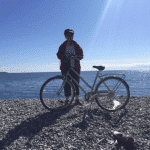Mysteries of Easter Island
Easter Island was given it’s name by the Dutch, who were the first Europeans to land here on Easter Day in 1722. It became part of Chile in the late 1800’s; however it is located 2,300 miles from the Chilean coast.
My entire travel career I have wanted to see the ancient Moai statues Easter Island is famous for, and I couldn’t believe this was the day! This morning we departed Hangaroa Eco Village at 9:30am, after a quick tour briefing by our guide, Hanga. The skies are clear on this warm spring day, as we drive through the small town of Hangaroa. This is the only town on Rapa Nui island and consists of approximately four main streets of tourist shops and restaurants followed by residential areas.
As we drive, wild horses and cows are creating road blocks. For me, this is just adding to the fun, less so for our patient driver. As we work our way toward the ocean, our guide is pointing out platforms where the Moai statues once stood. These platforms are called Ahu’s and no one knows exactly how they were made. The stone craftmanship is so precise, it reminds us of Stonehenge and the Inca ruins in Peru. Hanga is telling us there is no evidence that the Inca’s made it this far.
Easter Islanders are thought to have originated from the Marquesa Islands in the South Pacific, because they have a similar DNA and language. It is thought that due to overpopulation in the Marquesas, Chief Hotu Matua arrived at Easter Island with his extended family between 300-400 AD. The settlers named it Te Pito O Te Henua (Navel of the World), due to it being one of the most isolated islands on earth.
Reading Thor Heyerdahl’s book, Aku-Aku, was both interesting and educational. It gave great background to this mysterious place. It describes the 2 groups of native peoples who were known as the Long Ears and the Short Ears. The Long Ears put weights in their ears and wore elaborate feathered head pieces.
Today Hanga is explaining that the natives carved the ancient Moai statues from one rock quarry, each weighing 60 to 80 tons. She told us that there is a torso connected to each head but most are buried in the ground. The red topknot hair was carved from another quarry located on the other side of the island. Both were then transported to the coast and the hair was lifted to the head once at their final resting place. Next, the eyes were carved with coral inlay, placed on the statues, and then thought to take on a spirit protector. She explained that no one knows exactly how the transport was accomplished, but they theorize they used tree trunks as wooden rollers. This would explain the fact that there are no tree forests on the island. Legend, however, says that the Moai statues walked to their positions.
I could hardly contain my excitement as we approached the quarry. Hanga is telling us our park pass only allows for one visit to the quarry and volcano area, but will allow multiple visits to other archeological sites on the island. We have arrived on a day with few visitors. This is the advantage to visiting Easter Island in the spring. After presenting our park pass, we walked the path to the quarry, and I could see rock formations scattered here and there. Suddenly as I grew closer, I could see the formations were actually Moai statues. Some were on their side but most were standing upright. Some were in the process of being carved from the volcanic rock and others were ready for transport. I felt a chill from being so close to them. These Moai statues truly gave me the feeling that they do contain spirits. I feel so lucky to have been near them.

